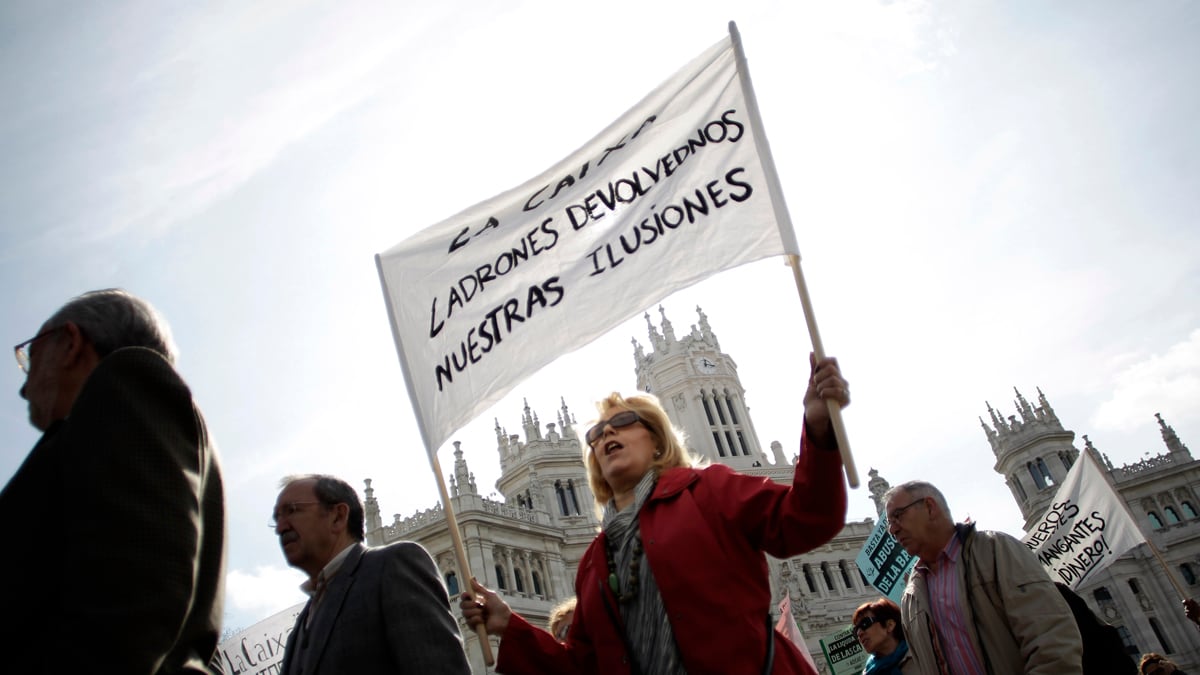What Are the Root Causes?
For a country with a relatively low debt problem before the global downturn in 2008, Spain took a surprising nosedive—then headed toward rock bottom. One culprit is the housing bubble created after low interest rates that came with adoption of the euro caused housing prices to triple in the decade between 1996 and 2007. Now the bubble has popped—leaving banks with bad mortgage debts and spending cutbacks. In addition, fast-rising wages led to overspending on cheap imports—against Spain’s expensive exports—and left the currency overvalued. As recently as last year, the country was spending 5 percent more than it was earning from the global market.
Nature of Spain’s Economy
The nation’s economy is reeling, and its unemployment rate is languishing at close to 25 percent—one of the highest in the euro zone. S&P recently downgraded the country’s credit rating from A to BBB because the economy is expected to shrink over the next two years. But the country’s economy remains the fourth largest in Europe, after Germany, France, and Italy. It also is the 13th-biggest economy in the world, more than four times the size of Greece’s. In fact, Spain will be the largest country in the euro zone to get a bailout so far. The economy’s size had led to fears that a sovereign bailout of Spain would have to be much larger than the bailout that went to Greece, Ireland, or Portugal and that it would strain the resources of Europe’s new bailout fund. Spain also has repeatedly warned that if its economy failed, that would bring down the euro.
How Big is the Spain Bailout?
The exact amount of Spain’s bailout is unknown, but it could be up to $125 billion. The exact amount will be revealed after outside accountants complete an audit of the banks by June 21. When an amount is settled on, the loans will be sent to the Spanish government’s Fund for Orderly Bank Restructuring, which was created at the outset of the crisis, but has since been nearly emptied helping the smaller failed banks. Also unknown is where the money will come from. It will either be sent from the European Financial Stability Facility—the zone’s $550 billion rescue fund—or the new $625 billion European Stability Mechanism.
How the Money Will Be Used
Spanish officials are quick to point out that the money will be specifically targeted at the country’s troubled banking sector. In other words, it is not a sovereign bailout, but a banking bailout. Some are referring to it as a “bailout lite” since it is targeted specifically at banks and is smaller than previous bailouts. In fact, Spanish Prime Minister Mariano Rajoy has attempted to avoid calling it bailout altogether, instead describing it as a “line of credit.” Government officials even claim that as long as banks pay back the money, it will not increase the nation’s deficit. They also insist that Spain will not need all the funds being offered, but that the $125 billion figure includes “a safety margin.” But not everyone thinks “bailout lite” will be enough. While the International Monetary Fund estimated that $46 billion would be the minimum bailout needed to shore up the country’s banking sector, JPMorgan expressed the belief that Spain eventually will need a full IMF/EU bailout, which the bank calculated would total between $350 billion and $450 billion.

The Bailout Comes Without Conditions
Rajoy was also quick to point out that, unlike the bailouts that went to Greece, Portugal, and Ireland, Spain’s banking bailout comes with no “conditionality.” While the banks that receive funding will have specific conditions placed upon them, officials say Spain itself will have no new economic rules imposed upon it from outside and will not have to accept cuts to the government’s budget. However, Rajoy plans to continue with the austerity measures his government has already put in place.
Spain Didn’t Want to Be Bailed Out
Spain wasn’t quick to jump on the bailout bandwagon. The country previously had resisted asking for international help, after watching the requirements placed on Greece, Portugal, and Ireland. Prime Minister Rajoy repeatedly insisted that there would be “no rescue of the Spanish banking sector,” while a senior minister said that “the men in black would not be coming to Spain.” But the self-assurance wasn’t built to last. German news outlet Spiegel learned that Germany Chancellor Angela Merkel and Finance Minister Wolfgang Schäuble decided that Spain should be required to take bailout funds and pressured the Spanish government to accept them.
Bailout Much Larger Than Greece’s
The question of a Spanish bailout weighed heavily on the leaders of Europe. Being the fourth-largest economy in the euro zone, Spain had a crisis that was far larger than Greece’s. While bailouts already had been implemented in Greece, Ireland, and Portugal, the scope of Spain’s would be many times larger and make it harder on the country, which would be burdened with especially high borrowing costs. But the pressure mounting from Greece’s upcoming elections helped push Spanish leaders to yield. Fear that a possible departure from the euro by Greece could shake the markets and adversely affect an already unstable Spain worried leaders, who decided to get help before fallout from other crises could damage them.
Spaniards Losing Faith in Their Leaders
With ever-rising foreclosures and unemployment rates, the Spaniards are less than enthusiastic about their government. Angry protesters stormed banks in Madrid, insisting that those responsible in the financial sector be investigated. A poll released Sunday showed a whopping 78 percent of citizens had “little or no” confidence in the ruling party. “This is not a rescue for Spain, it’s a rescue for the rich. The poor will only get poorer and suffer even more in the months to come,” one man told reporters. The Spanish leaders aren’t overoptimistic, either. Prime Minister Rajoy noted that even with the help, the economy was projected to shrink, and unemployment would rise. “This year is going to be a bad one,” Rajoy said.
How Has the Crisis Affected the U.S.?
While it’s unclear exactly what impact Spain’s distress crisis will have on the United States, it might not be as great as the impact European recession as a whole will have on this side of the Atlantic. America has about $50 billion in outstanding loans in Spain, which is relatively small compared with other countries. But the news that Spain would accept a bailout ricocheted to Wall Street, which in response saw its best week of the year. As a whole, the European debt crisis has more dire consequences on the American economy. “If Europe is weak, if Europe is not growing, as our largest trading partner, that’s going to have an impact on our businesses and our ability to create jobs here,” President Obama said. Many American industries are heavily invested in Europe, and the crisis could drag their profits down. In April, exports to the EU fell 11.1 percent. In addition, stock prices fluctuate based on fears of a European recession, which have been escalating in recent months with the possibility of Greece exiting the euro.





